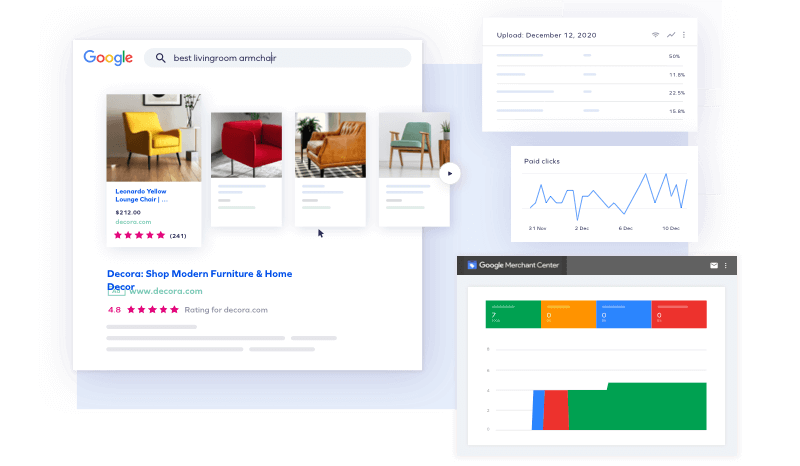What Is Google Merchant Center & How to Use It
The Google Merchant Center is the beating heart of every Google Shopping campaign. Here’s how to set it up, and why you need to get it right.
 Google Shopping Guide
Google Shopping Guide
The Google Merchant Center is the beating heart of every Google Shopping campaign. Here’s how to set it up, and why you need to get it right.
For small businesses setting up an online store, it isn’t necessarily true that “if you build it, they will come.” Instead, you need to drive traffic to your store and attract the types of shoppers who are interested in your products.

This is where Google comes in. About 82% of retail queries without a brand go through Google Shopping. That means most people looking for a “blue scarf” or “cordless drill” will start their online shopping with the Google search bar. The top of the search results will have a carousel of products, and the Google Shopping tab will offer the shopper even more options.
Even the smallest retailers can get their products listed, and it all happens with the platform called Google Merchant Center. Find out how Google Merchant Center can help you make more sales and increase your customer base.
Google Merchant Center is an online platform where retailers upload product details so that they can appear within Google search results.
GMC isn’t an online store where you’re selling products. Instead, it’s a listing service that can help shoppers find the products that you’re selling on your website or in an online marketplace. By adding product data to the Google Merchant Center, you’ll attract potential customers who are looking for the products you have.
Products added to Google Merchant Center can be used in two ways:
The Google Merchant Center is used for your product feed, but it’s not a standalone app. Instead, you can link it to other Google services, as well as tech platforms outside of Google. Through these integrations and linked services, you’ll be able to optimize your digital infrastructure and streamline operations.
The Google Merchant Center can integrate with:
This overview hub for your company lets you set your location, contact information, hours, link to a website, and business description. Registering your business gives you control over the information Google displays, and your company profile can be displayed as a sidebar alongside search results or within Maps.
Formerly called Google AdWords, this is a paid advertising platform that you can use for different types of paid display across Google’s brands. By linking Google Ads to your Google Merchant Center account, you’ll be able to use your product listings in your advertising campaigns.
This reporting tool can help you better understand online activity. There are performance reporting tools available within the Merchant Center, but Google Analytics can provide additional reports on product traffic including organic and paid results.
Remember that you are not limited to Google-to-Google integrations. You can sync with platforms like Shopify and connect with a range of third-party apps or Google partner services like Yotpo.
Google Merchant Center is useful for companies of all sizes. However, the platform has specific advantages for small businesses.
Your business may be small, but your online strategy doesn’t have to be. With Google Merchant Center, you have the opportunity to get your products displayed right next to the leaders of your industry.
Listing your products on Google improves your discoverability. Because of your product listings, a new customer may find that you’re selling the best product for their needs. Businesses that have a storefront can also attract local customers through local inventory ads which tell shoppers that you have an in-stock product nearby.
Anyone can sell online, but Google product listings can give you authority and credibility. Shoppers perceive information displayed on Google as independent and verifiable. For example, if your product listing has 50 five-star reviews, that will hold a lot of sway with future shoppers.
Google’s price competitiveness report provides free data about the pricing of similar products so you can understand how you stack up to the competition.
It can be hard for small businesses to break out amidst tough competition, but Google’s level playing field can help you compete. The key is to use every available optimization technique so that even if shoppers don’t recognize your brand name, they’re curious to know more. For example, one of our Google Shopping case studies explained how clothing retailer Alala was able to get an advantage over well-known competitors because they had the only product with strong customer ratings.
In a retail storefront, you may be able to spot the browsers from the buyers when they walk in the door. Similarly, online product listings are more geared toward searchers who have buying intent. This is why Google Shopping Ads have a 30% higher conversion rate than text ads on Google.
If you’re on a tight budget, you can list your products for free and only choose to implement paid ads where you have the potential to see the biggest results. Larger retailers may try to be ranked in multiple categories, but the flexibility of the platform allows small businesses to focus on the ads that could have the most impact.
It’s easier than you think to add product listings to Google.
“Yotpo is a fundamental part of our recommended tech stack.”
 Laura Doonin, Commercial Director
Laura Doonin, Commercial Director








